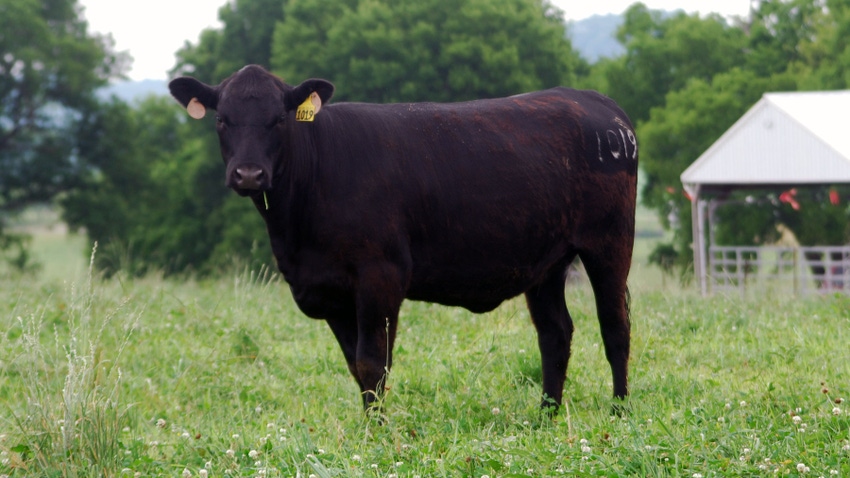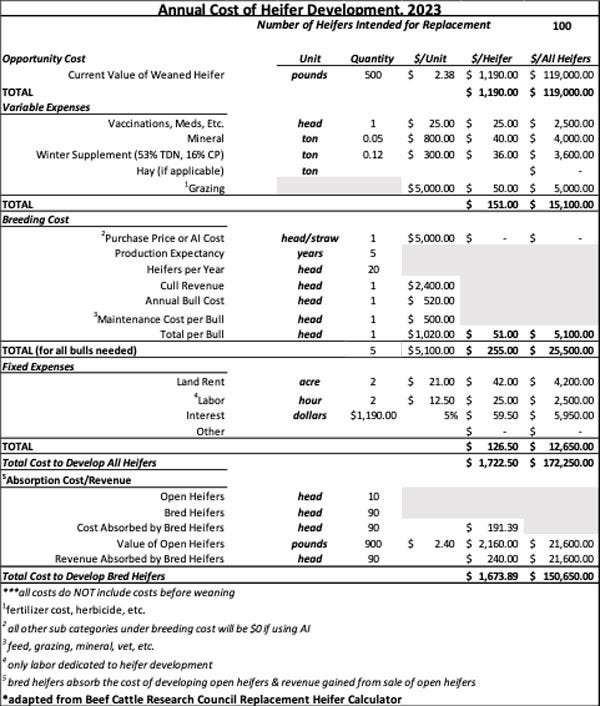January 3, 2024

By Hannah Baker, University of Florida
A common question asked each year by cattle producers is, “What should I do with my heifers? Should I raise them as replacements or sell them as weaned heifers?” This question is especially relevant in today’s market of high prices and the inevitability that expansion will have to start at some point.
The answer involves penciling out the expenses and deciding which option best suits an operation in the current market.
Costs of developing heifers include the current value of weaned heifers (opportunity cost), variable expenses, breeding costs, fixed expenses, and absorption costs. The Replacement Heifer Calculator discussed in this article aims to serve as a guide in organizing each of these costs and can be used as an estimation tool to calculate what it may cost to develop heifers on a specific operation and if it is economical to do so. The calculator includes several key cost concepts, including:
The opportunity cost of selling weaned heifers must be recognized. “What revenue will be forfeited if I decide to raise these heifers rather than selling them now?” Understanding the opportunity costs allows for comparisons at the end of the estimation process to see which option is the most economical for an operation.
Variable expenses (feed, medications, and pasture management) and fixed expenses (land rent, labor, and interest) are important for calculating what each heifer needs so that she will be 60-65% of her mature body weight at the time of breeding. A way to remember what costs will go into these sections is to ask: “What is needed for the health and nutrition of the heifer?” Variable expenses will vary across operations and from year to year due to fluctuating input costs. Fixed costs should remain roughly the same year to year but will vary across different operations. Interest is included to account for the time between the opportunity to sell them as weaned heifers until they are developed.
Breeding costs are just that: “What is it going to cost to breed each heifer?” Whether you are using bulls or artificial insemination (AI), there are costs associated with both. Using natural service involves the costs of purchasing and maintaining the bull or bulls. Annual cost is determined using the following formula: ((purchase cost – useful years in the herd)/value at culling). A bull’s maintenance cost is his total variable costs, similar to a heifer’s variable cost: “What are the costs associated with maintaining the health of a bull?” The annual bull cost plus the maintenance cost divided by the number of heifers he will be expected to breed is his total cost. This total cost is then multiplied by the number of bulls needed, and then divided by total number of heifers to calculate the breeding cost of each heifer.
Absorption costs represent the cost of developing open heifers. These costs are absorbed by the bred heifers that remain in the operation. However, absorbed costs can be offset by the revenue from selling those developed, open heifers. The cost to develop all heifers is multiplied by the number of open heifers and then divided by the number of bred heifers to assign additional development cost to each bred heifer (cost absorbed). The revenue received by the sale of open heifers is then divided by the number of bred heifers to offset the additional development cost (revenue absorbed). All totals from each section can now be summed to estimate the cost of developing heifers.
As an example, current prices for weaned heifers in Florida have been well above $2.00 per lb. since April 2023 and are continuing to rise. Prices for replacement cattle, open or bred, can be expected to follow the same trend in Florida as the demand for and value of replacement cattle increases when expansion begins to occur.
Understanding the full cost to develop heifers allows you to compare that cost to selling heifers at weaning and buying bred replacements. If the price of bred heifers is greater than the total cost to develop bred heifers, a potentially profitable investment has been made in your heifers.
Of course, also important to the decision is your strategy for genetic development, which must be weighed against the value of weaned heifers, development costs, and the cost of purchased replacements. These decisions are all about the goals and risk management strategies of each operation.

According to the example in Table 1, the total cost to develop 100 heifers is $172,250 or $1,722.5/hd. However, after considering the revenue of selling 10 open culls, the net development cost is reduced to a total of $150,650 or $1,673.89/hd for each of the remaining 90 bred heifers. The current value of young, bred replacement cattle with an average weight of 1,100 pounds is $1.54 per lb. or roughly $1,700/hd in Florida. Using the results of the example, you would save approximately $27/hd or a total of $2,430 if you raised your replacements (90) rather than buying them.
Even though the price you would have received for selling weaned heifers is higher than the cost of development, the long-term outcome in this scenario suggests that the cost of development was worth the investment. With the value of female cattle expected to rise in the coming months due to inevitable expansion, raising your own replacements to rebuild your herd may be a more economical decision.
Expenses can be overwhelming when looked at as a short-term lump sum. So, it is important to look at them as long-term investments when possible. To download the Replacement Heifer Cost Estimation Tool click here.
Source: Southern Ag Today, a collaboration of economists from 13 Southern universities.
Read more about:
BeefYou May Also Like




